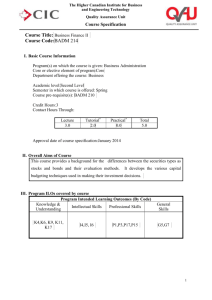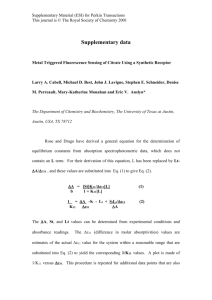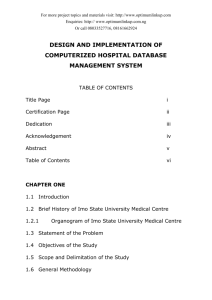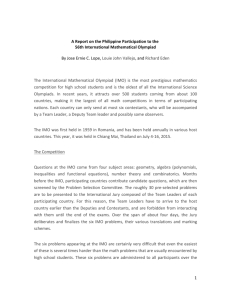COURSE TITLE (COURSE CODE)
advertisement
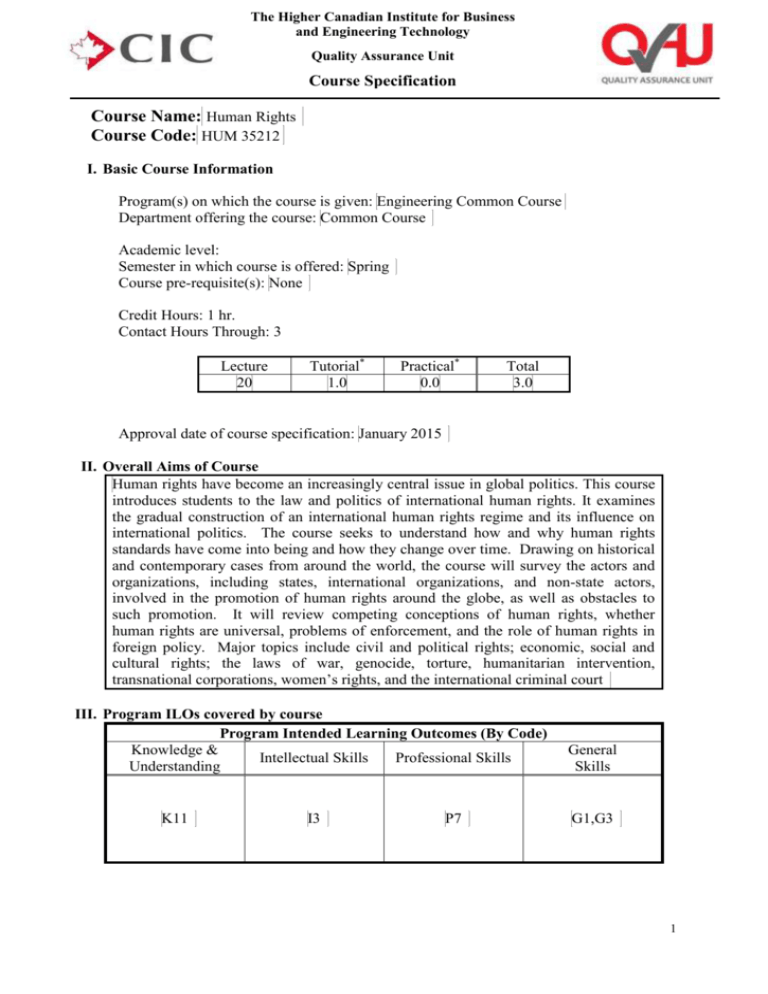
The Higher Canadian Institute for Business and Engineering Technology Quality Assurance Unit Course Specification Course Name: Human Rights Course Code: HUM 35212 I. Basic Course Information Program(s) on which the course is given: Engineering Common Course Department offering the course: Common Course Academic level: Semester in which course is offered: Spring Course pre-requisite(s): None Credit Hours: 1 hr. Contact Hours Through: 3 Lecture 20 Tutorial* 1.0 Practical* 0.0 Total 3.0 Approval date of course specification: January 2015 II. Overall Aims of Course Human rights have become an increasingly central issue in global politics. This course introduces students to the law and politics of international human rights. It examines the gradual construction of an international human rights regime and its influence on international politics. The course seeks to understand how and why human rights standards have come into being and how they change over time. Drawing on historical and contemporary cases from around the world, the course will survey the actors and organizations, including states, international organizations, and non-state actors, involved in the promotion of human rights around the globe, as well as obstacles to such promotion. It will review competing conceptions of human rights, whether human rights are universal, problems of enforcement, and the role of human rights in foreign policy. Major topics include civil and political rights; economic, social and cultural rights; the laws of war, genocide, torture, humanitarian intervention, transnational corporations, women’s rights, and the international criminal court III. Program ILOs covered by course Program Intended Learning Outcomes (By Code) Knowledge & Intellectual Skills Professional Skills Understanding K11 I3 P7 General Skills G1,G3 1 The Higher Canadian Institute for Business and Engineering Technology Quality Assurance Unit Course Specification Intended Learning Outcomes of Course (ILOs) a. Knowledge and Understanding On completing the course, students should be able to: k. 1 Outline topics related to humanitarian interests and moral issues b. Intellectual/Cognitive Skills On completing the course, students should be able to: i.1 Select appropriate solutions for engineering problems based on analytical thinking c. Practical/Professional Skills On completing the course, students should be able to: p.1 Implement comprehensive understanding of intellectual skills in project d. General and Transferable Skills On completing the course, students should be able to: g.1 Collaborate effectively within multidisciplinary team. g.2 Communicate effectively IV. Course Matrix Contents Main Topics / Chapters 1- 2- 3456789- Course Overview : Part I: Introduction, Theory, and History Theoretical Perspectives II: Constructivism, Critical Theory Are Human Rights Universal? The Cultural Relativism Debate Part II: The Promotion of Human Rights The International Human Rights Regime Universal Jurisdiction and the International Criminal Court s The Laws of War Case: The U.S and torture: Iraq, Guantanamo, Afghanistan Donnelly, Ch. 14, “Globalization, the State and Duration (Weeks) 1 Course ILOs Covered by Topic (By ILO Code) K&U I.S. P.S. G.S. K11 G1,3 K11 P7 G3 K11 P7 G3 K11 P7 G3 K11 P7 G3 K11 P7 G3 K11 K11 P7 G3 G3 1 1 1 1 1 1 1 1 K11 G3 2 The Higher Canadian Institute for Business and Engineering Technology Quality Assurance Unit Course Specification Human Rights.” III. Globalization and 10 Human Rights Modern Slavery 11- Humanitarian Intervention 12- Women’s Rights Net Teaching Weeks K11 G3 K11 K11 G3 G3 1 1 1 12 V. Course Weekly Detailed Topics / hours / ILOs Week No. 1 2 3 Sub-Topics course overview : Introduction: Human rights in world politics [ watch this online on Canvas] Donnelly, Ch. 1, “Human Rights as an Issue in World Politics.” Kenneth Roth, “The Day After,” Human Rights Watch, World Report 2013. Why human rights matter: the case of El Salvador Danner, The Massacre at El Mozote Donnelly, Ch. 8, pp. 113-123. We will discuss the book in class. NOTE: video: “Justice and the Generals” (2002) El Salvador (con’t.). Theoretical Perspectives I: Realism, liberalism Donnelly, Ch. 2, “Theories of Human Rights.” Kathryn Sikkink, “Introduction to the Origins of Human Rights Policies,” in Mixed Signals: U.S. Human Rights Policy and Latin America (Cornell, 2004), pp. 3-22. (C) Stephen Krasner, Sovereignty: Organized Hypocrisy (Princeton, 1999), p. 67-71 Theoretical Perspectives II: Constructivism, Critical Theory Keck and Sikkink, “Transnational Advocacy Networks in International Politics,”in Activists Beyond Borders (Cornell, 1998), pp. 1-38. (C) Makau Mutua, “Savages, Victims and Saviours: The Metaphor of Human Rights,” Harvard International Law Journal, Vol. 42 (2001), pp. 201-245. (C) The Rise of Human Rights: WWII, Nuremberg and the Universal Declaration Kathryn Sikkink, “The Idea of Internationally Recognized Human Rights,” in Mixed Signals: U.S. Human Rights Policy and Latin America (Cornell,2004), pp. 23-47. (C) Contact Hours Total Theoretical Practical Hours Hours Hours* 3 2 3 2 1 3 2 1 3 The Higher Canadian Institute for Business and Engineering Technology Quality Assurance Unit Course Specification 4 5 Ashild Samnoy, “The Origins of the Universal Declaration of Human Rights,” in Alfredsson and Eide, eds., The Universal Declaration of Human Rights: A Common Standard of Achievement (The Hague: Matinus Nijhoff, 1998), pp. 3-22. (C) Discussion sections begin. Are Human Rights Universal? The Cultural Relativism Debate Donnelly, Ch. 3, “The Relative Universality of Human Rights.” Bilihari Kausikan, “Asia’s Different Standard,” Foreign Policy, No. 92 (Autumn1993). (C) Mahmoud Monshipouri, “The Muslim World Half A Century After the Universal Declaration of Human Rights: Progress and Obstacles,” Netherlands Quarterly of Human Rights (1998), pp. 287-314. (C) Cultural relativism: cases Frances Althaus, “Female Circumcision: Rite of Passage or Violation of Rights?” International Family Planning Perspectives (September 1997), pp. 130-133 (C). M. Baer and A. Brysk, “New Rights, Private Wrongs: Female Genital Mutilation and Global Framing Dialogues,” in Clifford Bob, eds., The International Struggle for New Human Rights (2009), 93-107. (C) Burqa case: Phyllis Chesler, “Ban the Burqa? The Argument in Favor,” Middle East Quarterly (Fall 2010). (C) Martha Nussbaum, “Veiled Threats?” at: http://opinionator.blogs.nytimes.com/2010/07/11/veiledthreats/ (skim the “comments”). discussion sections Part II: The Promotion of Human Rights The International Human Rights Regime Donnelly, Chs. 5-7. Luisa Blanchfield, The United Nations Human Rights Council: Issues for Congress. Congressional Research Service (April 2013). (C) Balakrishnan Rajagopal, “Who Failed Whom? Assessing the UN’s Human Rights Efforts,” Audit of the Conventional Wisdom, MIT Center for International Studies, October 2007. (C) “Does the U.S. deserve its new seat on the Human Rights Council?” Colum Lynch, Turtle Bay (blog), Monday, November 12, 2012. International and regional human rights regimes (con’t.) 3 2 1 3 2 1 4 The Higher Canadian Institute for Business and Engineering Technology Quality Assurance Unit Course Specification 6 7 8 9 10 Short essay due. Discussion Human Rights and Foreign Policy: The United States and Human RightsDonnelly, pp. 124-135; Ch. 9. Michael Ignatieff, “Introduction: American Exceptionalism and Human Rights,” in Ignatieff, ed., American Exceptionalism and Human Rights (Princeton, 2005), pp. 1-26. (C) Government of China, “Human Rights Record of the United States in 2012,” at http://news.xinhuanet.com/english/world/201304/21/c_132327175.htm (skim) Colum Lynch, “US Subjects its Human Rights Record to Review by UN Council,” Washington Post, November 5, 2010. (google) Human Rights and the Arab Spring Vera Van Huellen, “The ‘Arab Spring’ and the Spiral Model: Tunisia and Morocco,” in Risse, Ropp and Sikkink, The Persistent Power of Human Rights (Cambridge, 2013), pp. 182-199. discussion sections Midterm Exam Universal Jurisdiction and the International Criminal Court David Forsyth, “Transitional Justice: Criminal Courts and Alternatives” in Human Rights in International Relations (2012), pp. 117-152. Henry Kissinger, “The Pitfalls of Universal Jurisdiction,” Foreign Affairs, 80 (July/August 2001). (C) Kenneth Roth, “The Case for Universal Jurisdiction,” Foreign Affairs (Sept/Oct. 2001). (C) David Kaye, “Who’s Afraid of the International Criminal Court?” Foreign Affairs (May/June 2011). (C) Adam Branch, “International Justice, Local Injustice,” Dissent (Summer 2004). (C) Mahmood Mamdani, “The New Humanitarian Order?” The Nation, September 29, 2008. (C) Solomon Dersso, “The International Criminal Court’s Africa Problem,” Al Jazeera, June 11, 2013.David Bosco, “Why is the International Criminal Court picking only on Africa?” WP Opinions, March 29, 2013 ICC roleplaying video: The Torture Question (2005) The Laws of War (go to lecture, no discussion sections today) Donnelly, Ch. 15, “(Anti)Terrorism and Human Rights.” Steven Ratner, “The Geneva Conventions: Think Again,” Foreign Policy (March/April 2008). (C) Case: The U.S and torture: Iraq, Guantanamo, 3 2 1 3 2 1 3 2 1 3 2 1 5 The Higher Canadian Institute for Business and Engineering Technology Quality Assurance Unit Course Specification 11 12 Afghanistan David Forsythe, “The United States and International Humanitarian Law,” Journal of Human Rights (Jan-Mar 2008). (C) Torture memos: Gonzales to Bush, Jan. 25, 2002 Powell to White House, Jan. 26, 2002 Taft to Gonzales, Feb. 2, 2002, 1st two pages Bybee to Gonzales, August 1, 2002, 1st two pages (To download, google “torture memos new york times”). Amitai Etzioni, “Terrorists: Neither Soldiers Nor Criminals,” Military Review (July/August 2009). (C) Case: The 2008-09 Gaza War UN Goldstone Report, read Executive Summary (September 2009). ( download by googling “Goldstone report” ). Moshe Halbertal, “The Goldstone Illusion,” The New Republic, Nov. 6, 2009.C) Robert Bernstein, “Rights Watchdog, Lost in the Middle East” New York Times, Oct. 19, 2009. Kenneth Roth, “Human Rights Watch Applies the Same Standards to Israel, Hamas,” Ha’aretz, October 26, 2009. discussion Video: Free Trade Slaves (1999) Donnelly, Ch. 14, “Globalization, the State and Human Rights.” Transnational Corporations Forsythe, “Transnational Corporations and Human Rights,” in Human Rights in International Relations (Cambridge, 2012), pp. 277-314. (C) Debora Spar, “The Spotlight and the Bottom Line: How Multinationals Export Human Rights,” Foreign Affairs (March/April 1998). (C) Chris Albin-Lackey, “Without Rules: A Failed Approach to Corporate Accountability,” Human Rights Watch, World Report 2013, pp. 29-40. discussion. Modern Slavery [Begin reading A Problem from Hell] Ethan Kapstein, “The New Global Slave Trade,” Foreign Affairs (Nov./Dec.2006) (C). Natasa Kovasevic, “Child Slavery: India’s SelfPerpetuating Dilemma,” Harvard International Review, Vol. 29, No. 2 (Summer 2007). (C)discussion. Paper topics due (a paragraph). Humanitarian Intervention 3 2 1 3 2 1 6 The Higher Canadian Institute for Business and Engineering Technology Quality Assurance Unit Course Specification 13 Genocide power, A Problem From Hell, Chs. 1-5, 7, 10-11, 13-14. (253 pp) Donnelly, Ch. 13, “Humanitarian Intervention Against Genocide.” David Reiff, “The Institution that Saw No Evil,” The New Republic, Feb. 12, 1996. (C) discussion The Responsibility to Protect Alex Bellamy, “R2P Dead or Alive?” in Responsibility to Protect – From Evasive to Reluctant Action? (Hans Seidel Foundation, 2012), pp. 11-28. Case: Libya Jon Western and Joshua S. Goldstein, “Humanitarian Intervention Comes of Age,” Foreign Affairs (Nov/Dec. 2011).David Rieff, “R2P, R.I.P.” New York Times, Nov. 7, 2011. Alan J. Kuperman, “A Model Humanitarian Intervention? Reassessing NATO's Libya Campaign,” International Security (Summer 2013), Vol. 38, No. 1, pp. 105-136. Women’s Rights Are women’s rights human rights? Hilary Charlesworth, “What are Women’s International Human Rights?” (1994) (C) Madhu Mehra, “India’s CEDAW Story,” in Hellum and Aasen, eds., Women's Human Rights: CEDAW in International, Regional and National Law (2013). (C) George Will, “Another Pose of Rectitude” Newsweek (2002). (C) Final Exam Total Teaching Hours 3 2 1 39 26 12 VI. Teaching and Learning Methods Teaching/Learning Method Lectures & Seminars Tutorials Computer lab Sessions Practical lab Work Reading Materials Web-site Searches Research & Reporting Problem Solving / Problem-based Learning Course ILOs Covered by Method (By ILO Code) K&U K11 K11 K11 K11 K11 Intellectual Skills Professional Skills P7 P7 General Skills G1,3 G1,3 G1,3 G1,3 G1,3 7 The Higher Canadian Institute for Business and Engineering Technology Quality Assurance Unit Course Specification Projects Independent Work Group Work Case Studies Presentations Simulation Analysis K11 K11 K11 P7 P7 P7 G1,3 G1,3 G1,3 K11 P7 G1,3 Others (Specify): VII. Assessment Methods, Schedule and Grade Distribution Course ILOs Covered by Method (By ILO Code) Assessment Method Midterm Exam Final Exam Quizzes Course Work Report Writing Case Study Analysis Oral Presentations Practical Group Project Individual Project K&U I.S. K11 K11 K11 K11 K11 P.S. G.S. Assessment Weight / Percentage P7 P7 P7 P7 G3 G3 G3 G3 G3 20 50 10 50 - Week No. 8 15 2 14 K11 P7 G3 K11 K11 K11 P7 P7 P7 G3 G3 G3 10 10 Others (Specify): VIII. List of References Essential Text Books “Jack Donnelly, International Human Rights (Westview, 2012), 4th ed. Mark Danner, The Massacre at El Mozote (Vintage, 1993). Samantha Power, A Problem From Hell: America and the Age of Genocide (Harper Perennial, 2003). Course notes Recommended books Periodicals, Web sites, etc … Course Management System CMS IX. Facilities required for teaching and learning lecture rooms - computers - data show Course coordinator: Dr. Mohamed Attia 8 The Higher Canadian Institute for Business and Engineering Technology Quality Assurance Unit Course Specification Head of Department: Associate Professor/ Hamdy Hussien Date: January 2015 9

